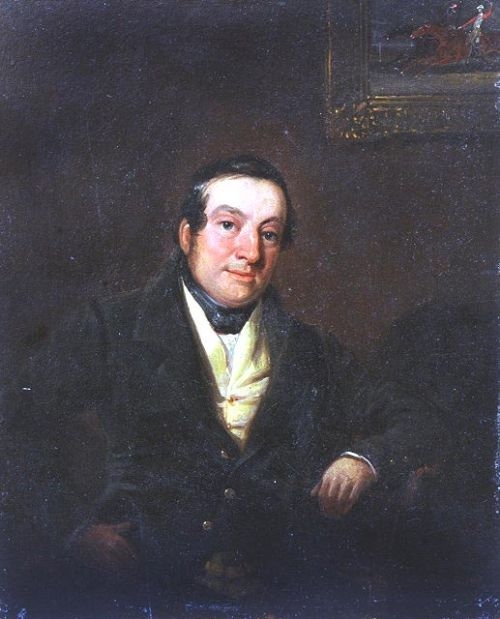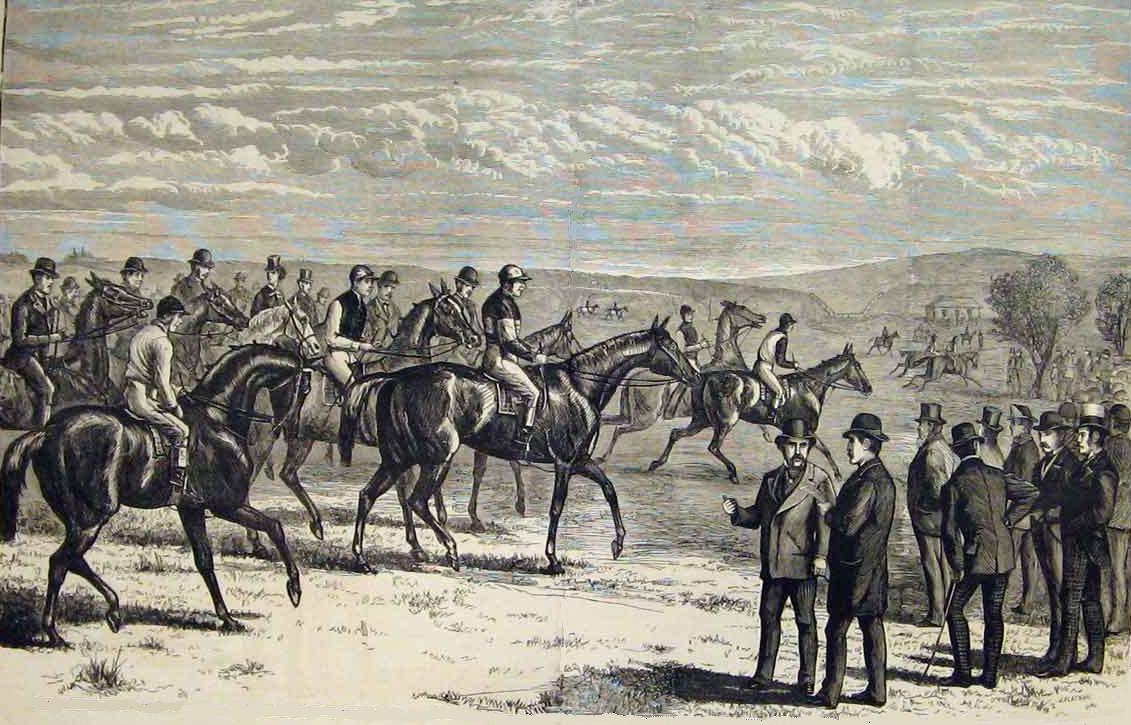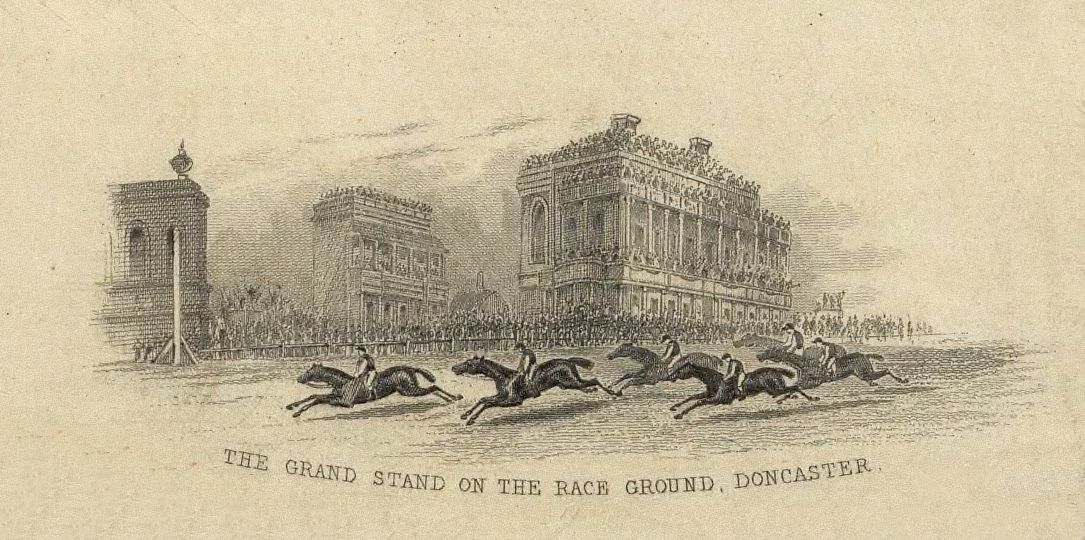|
Daniel O'Rourke (horse)
Daniel O'Rourke (1849 – after 1869) was a British Thoroughbred racehorse and sire. In a career that lasted from September 1851 to July 1853 he ran eleven times and won two races. In the summer of 1852, he proved himself one of the best British colts of his generation, winning the Derby at Epsom and the St James's Palace Stakes. Daniel O'Rourke came into the Derby as a maiden and won as an unconsidered outsider on heavy ground. He was one of the smallest Thoroughbreds to win a notable race, being technically a pony under some definitions of the term. Background Daniel O'Rourke was a compact, powerfully-built chestnut colt with a narrow white stripe and one white foot. He was bred by his owner John Bowes at Streatlam Castle, County Durham. At the peak of his success in 1852, Daniel O'Rourke was measured at 14.2 hands high, although as a stallion he grew to be over 15 hands. He was sired by Birdcatcher, a successful Irish racehorse who became an important and influential stal ... [...More Info...] [...Related Items...] OR: [Wikipedia] [Google] [Baidu] |
Harry Hall (painter)
Harry Hall (c. 1814 – 22 April 1882) was an English equestrian painter, whose works were in demand by horse owners. His output was prolific and he was the foremost racehorse portraitist of his time: his style has been described as being "strikingly modern... when compared with many of his contemporaries". He also produced other types of portraits and shooting scenes. Career Hall was born in Cambridge sometime around the middle of the second decade of the 19th century (dates of 1813, 1814, 1815, and 1816 are to be found in biographies). He first appeared as an artist at Tattersalls, working on a number of their publications; initially ''British Racehorses'' and ''The Sporting Review''. He graduated to become chief artist of '' The Field''. He produced a great volume of work, much of which was engraved. ''The Sporting Magazine'' published 114 plates by Hall. He also worked for ''The Illustrated London News''. Hall began life as a portrait painter, and exhibited at the Royal A ... [...More Info...] [...Related Items...] OR: [Wikipedia] [Google] [Baidu] |
Hand (unit)
The hand is a non- SI unit of measurement of length standardized to . It is used to measure the height of horses in many English-speaking countries, including Australia, Canada, the Republic of Ireland, the United Kingdom, and the United States. It was originally based on the breadth of a human hand. The adoption of the international inch in 1959 allowed for a standardized imperial form and a metric conversion. It may be abbreviated to "h" or "hh". Although measurements between whole hands are usually expressed in what appears to be decimal format, the subdivision of the hand is not decimal but is in base 4, so subdivisions after the radix point are in quarters of a hand, which are inches. Thus, 62 inches is fifteen and a half hands, or 15.2 hh (normally said as "fifteen-two", or occasionally in full as "fifteen hands two inches"). Terminology "Hands" may be abbreviated to "h", or "hh". The "hh" form is sometimes interpreted as standing for "hands high". When spoken a ... [...More Info...] [...Related Items...] OR: [Wikipedia] [Google] [Baidu] |
Stockwell (horse)
Stockwell (1849–1870) was a British Thoroughbred racehorse and a Leading sire in Great Britain & Ireland seven times; he was second on the sires' list a further four times during a 14-year period. Breeding Stockwell was foaled in Stockwell, England, at the stud farm of William Theobald. His sire, The Baron was a successful racehorse and sire. His dam Pocahontas was a roarer – a trait never demonstrated in Stockwell himself, but passed to several of his descendants. Pocahontas later also produced the successful sires, Rataplan and King Tom.Ahnert, Rainer L. (editor in chief), "Thoroughbred Breeding of the World", Pozdun Publishing, Germany, 1970 The chestnut was not a particularly pretty horse; he was described by one turf writer as "the very incarnation of ugliness," possessing a plain head with a slight Roman nose and hindquarters like a carthorse. He had good feet, strong legs and was very powerful, however, giving him the ability to carry high weights. Although a p ... [...More Info...] [...Related Items...] OR: [Wikipedia] [Google] [Baidu] |
2000 Guineas
The 2000 Guineas Stakes is a Group 1 flat race in Great Britain open to three-year-old thoroughbred colts and fillies. It is run on the Rowley Mile at Newmarket over a distance of 1 mile (1,609 metres) and scheduled to take place each year at the start of May. It is one of Britain's five Classic races, and at present it is the first to be run in the year. It also serves as the opening leg of the Triple Crown, followed by the Derby and the St Leger, although the feat of winning all three has been rarely attempted in recent decades. History The 2000 Guineas Stakes was first run on 18 April 1809, and it preceded the introduction of a version for fillies only, the 1000 Guineas Stakes, by five years. Both races were established by the Jockey Club under the direction of Sir Charles Bunbury, who had earlier co-founded the Derby at Epsom. The races were named according to their original prize funds ( ... [...More Info...] [...Related Items...] OR: [Wikipedia] [Google] [Baidu] |
John Scott, Horseman
John is a common English name and surname: * John (given name) * John (surname) John may also refer to: New Testament Works * Gospel of John, a title often shortened to John * First Epistle of John, often shortened to 1 John * Second Epistle of John, often shortened to 2 John * Third Epistle of John, often shortened to 3 John People * John the Baptist (died c. AD 30), regarded as a prophet and the forerunner of Jesus Christ * John the Apostle (lived c. AD 30), one of the twelve apostles of Jesus * John the Evangelist, assigned author of the Fourth Gospel, once identified with the Apostle * John of Patmos, also known as John the Divine or John the Revelator, the author of the Book of Revelation, once identified with the Apostle * John the Presbyter, a figure either identified with or distinguished from the Apostle, the Evangelist and John of Patmos Other people with the given name Religious figures * John, father of Andrew the Apostle and Saint Peter * Pop ... [...More Info...] [...Related Items...] OR: [Wikipedia] [Google] [Baidu] |
Internet Archive
The Internet Archive is an American digital library with the stated mission of "universal access to all knowledge". It provides free public access to collections of digitized materials, including websites, software applications/games, music, movies/videos, moving images, and millions of books. In addition to its archiving function, the Archive is an activist organization, advocating a free and open Internet. , the Internet Archive holds over 35 million books and texts, 8.5 million movies, videos and TV shows, 894 thousand software programs, 14 million audio files, 4.4 million images, 2.4 million TV clips, 241 thousand concerts, and over 734 billion web pages in the Wayback Machine. The Internet Archive allows the public to upload and download digital material to its data cluster, but the bulk of its data is collected automatically by its web crawlers, which work to preserve as much of the public web as possible. Its web archiving, web archive, the Wayback Machine, contains hu ... [...More Info...] [...Related Items...] OR: [Wikipedia] [Google] [Baidu] |
Filly
A filly is a female horse that is too young to be called a mare. There are two specific definitions in use: *In most cases, a ''filly'' is a female horse under four years old. *In some nations, such as the United Kingdom and the United States, the world of horse racing sets the cutoff age for fillies as five. Fillies are sexually mature by two and are sometimes bred at that age, but generally, they should not be bred until they themselves have stopped growing, usually by four or five.Ensminger, M. E. ''Horses and Horsemanship: Animal Agriculture Series.'' Sixth Edition. Interstate Publishers, 1990. p. 149-150 Some fillies may exhibit estrus as yearlings. The equivalent term for a male is a colt. When horses of either sex are less than one year, they are referred to as foals. Horses of either sex between one and two years old may be called yearlings. See also * Filly Triple Crown * Weanling A weanling is an animal that has just been weaned. The term is usually used to ... [...More Info...] [...Related Items...] OR: [Wikipedia] [Google] [Baidu] |
Fractional Odds
Odds provide a measure of the likelihood of a particular outcome. They are calculated as the ratio of the number of events that produce that outcome to the number that do not. Odds are commonly used in gambling and statistics. Odds also have a simple relation with probability: the odds of an outcome are the ratio of the probability that the outcome occurs to the probability that the outcome does not occur. In mathematical terms, where p is the probability of the outcome: :\text = \frac where 1-p is the probability that the outcome does not occur. Odds can be demonstrated by examining rolling a six-sided die. The odds of rolling a 6 is 1:5. This is because there is 1 event (rolling a 6) that produces the specified outcome of "rolling a 6", and 5 events that do not (rolling a 1,2,3,4 or 5). The odds of rolling either a 5 or 6 is 2:4. This is because there are 2 events (rolling a 5 or 6) that produce the specified outcome of "rolling either a 5 or 6", and 4 events that do n ... [...More Info...] [...Related Items...] OR: [Wikipedia] [Google] [Baidu] |
Newmarket Racecourse
Newmarket Racecourse is a British Thoroughbred horse racing venue in Newmarket, Suffolk, Newmarket, Suffolk, comprising two individual racecourses: the Rowley Mile and the July Course. Newmarket is often referred to as the headquarters of Horse racing in the United Kingdom, British horseracing and is home to the largest cluster of training yards in the country and many key horse racing organisations, including Tattersalls, the National Horseracing Museum and the National Stud. Newmarket hosts two of the country's five British Classic Races, Classic Races – the 1,000 Guineas and 2,000 Guineas, and numerous other Group races. In total, it hosts 9 of British racing's List of British flat horse races#Group 1, 36 annual Group One, Group 1 races. History Racing in Newmarket was recorded in the time of James VI and I, James I. The racecourse itself was founded in 1636. Around 1665, Charles II of England, Charles II inaugurated the Newmarket Town Plate and in 1671 became the fi ... [...More Info...] [...Related Items...] OR: [Wikipedia] [Google] [Baidu] |
Doncaster Racecourse
Doncaster Racecourse (also known as the Town Moor course) is a racecourse in Doncaster, South Yorkshire, England. It hosts two of Great Britain's 36 annual Group 1 flat races, the St Leger Stakes and the Racing Post Trophy. History Doncaster is one of the oldest (and the largest in physical capacity) established centres for horse racing in Britain, with records of regular race meetings going back to the 16th century. A map of 1595 already shows a racecourse at Town Moor. In 1600 the corporation tried to put an end to the races because of the number of ruffians they attracted, but by 1614 it acknowledged failure and instead marked out a racecourse. Doncaster is home to two of the World's oldest horse races: The Doncaster Cup The earliest important race in Doncaster's history was the Doncaster Gold Cup, first run over Cantley Common in 1766. The Doncaster Cup is the oldest continuing regulated horse race in the world. Together with the Goodwood Cup and Ascot Gold ... [...More Info...] [...Related Items...] OR: [Wikipedia] [Google] [Baidu] |
Champagne Stakes (Great Britain)
The Champagne Stakes is a Group 2 flat horse race in Great Britain open to two-year-old colts and geldings. It is run at Doncaster over a distance of 7 furlongs and 6 yards (1,414 metres), and it is scheduled to take place each year in September. History The event was established in 1823, and it was originally open to horses of either gender. For a period it was contested over a mile, and it was shortened to 6 furlongs in 1870. It was extended to 7 furlongs in 1962, and restricted to male horses in 1988. The Champagne Stakes is held during Doncaster's four-day St. Leger Festival, and it is currently run on the final day, the same day as the St Leger Stakes. The leading horses from the race sometimes go on to compete in the following month's Dewhurst Stakes. Records Leading jockey (9 wins): * Bill Scott – ''Swiss (1823), Memnon (1824), The Colonel (1827), Francesca (1831), Cotillon (1833), Jereed (1836), Don John (1837), Launcel ... [...More Info...] [...Related Items...] OR: [Wikipedia] [Google] [Baidu] |
Malton, North Yorkshire
Malton is a market town, civil parish and electoral ward in North Yorkshire, England. Historically part of the North Riding of Yorkshire, the town is the location of the offices of Ryedale District Council and has a population of around 13,000 people, measured for both the civil parish and the electoral ward at the 2011 Census as 4,888. The town is located to the north of the River Derwent which forms the historic boundary between the North and East Ridings of Yorkshire. Facing Malton on the other side of the Derwent is Norton. The Karro Food Group (formerly known as Malton Bacon Factory), Malton bus station and Malton railway station are located in Norton-on-Derwent. Malton is the local area's commercial and retail centre. In the town centre there are small traditional independent shops and high street names. The market place has recently become a meeting area with a number of coffee bars and cafés opening all day to complement the public houses. Malton has been descri ... [...More Info...] [...Related Items...] OR: [Wikipedia] [Google] [Baidu] |






